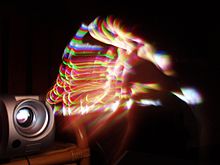Rainbow effect
When rainbow effect ( English rainbow effect , in short: RBE ) takes a viewer of self-luminous images true to edges in the image gradients, which are not intended and come through the image display method about. The rainbow effect occurs in picture display devices (still picture as well as moving picture) that display colors in a time division multiplex process, that is, one after the other or at least shifted in time. Well-known representatives are single-chip DLPs , but also TFT screens with color-discontinuous background light.
In these, a colored image is represented by projecting individual color images in different colors (at least three, often four to five) one after the other. Due to the sluggishness of the human eye, these images usually merge into one colored impression. However, this only applies as long as the partial images are also projected onto one another on the retina, i.e. as long as the eye does not carry out any (micro) saccades or conscious eye movements.
The rainbow effect occurs in principle in all people, but the disruptive effect depends on personal preferences and the speed of sight, which can also fluctuate depending on how you feel. The effect is also attributed to headaches or nausea after prolonged viewing. The strength of the effect also depends on the image material used: black-and-white images, hard contrasts and fast subject movements intensify the effect.
Technically, the effect can be reduced by increasing the multiplex frequency (higher number of revolutions or larger number of color segments of the color wheel). The effect does not occur with more expensive three-chip DLPs without a color wheel.
Possibilities of observation
The following methods can be used to detect devices with time-sequential color display by observing the projected image:
- Looking at the projection lens of the projector. This colored spot is usually one color. If it shows sporadic colored edges, the device tends to have a rainbow effect.
- With rapid image sequences, the RGB colors are particularly visible in white image areas or on the contours of the object.
- You can see this effect even more clearly if you stretch your hand into the beam path and move it back and forth.
- On the viewfinder monitor of a digital camera, the screen alternates in the RGB colors.
- If a digital camera is moved quickly when exposing an image on the screen, the effect is also visible.
Time-sequential color display is mainly found in DLP projectors. LCD models work with dichroic beam splitters and combiners as well as with multiple LCD chips. Until recently, time division multiplex was out of the question due to the switching speeds.
Trivia
- The first color television method used time division multiplexing of colors (introduced by Peter Carl Goldmark on August 29, 1940).
- Classic low-frequency fluorescent lamps also have a rainbow effect, as the light color changes within 10 ms (or 8.33 ms) of a half-cycle of the supply voltage.


